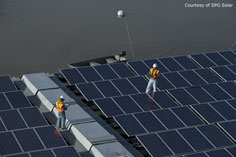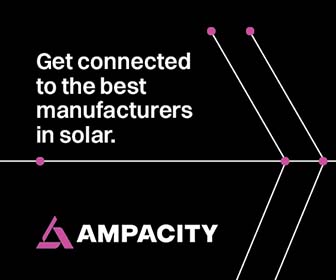Solar Power Keeps Water Agencies and Wastewater Treatment Facilities Afloat
 Electricity costs are among the largest portions of the annual operating budget for water and wastewater treatment facilities. In fact, electricity accounts for roughly 80% of municipal water and wastewater processing and distribution costs. According to the US Environmental Protection Agency (EPA), $4 billion is used in treating wastewater and delivering drinking water. In Massachusetts alone, $150 million per year is spent by cities and towns on electricity costs to treat 662 billion gallons of wastewater and drinking water. In New York, this adds up to between $250 and $300 million.
Electricity costs are among the largest portions of the annual operating budget for water and wastewater treatment facilities. In fact, electricity accounts for roughly 80% of municipal water and wastewater processing and distribution costs. According to the US Environmental Protection Agency (EPA), $4 billion is used in treating wastewater and delivering drinking water. In Massachusetts alone, $150 million per year is spent by cities and towns on electricity costs to treat 662 billion gallons of wastewater and drinking water. In New York, this adds up to between $250 and $300 million.
With electricity costs increasing by nearly 22% in the past five years—with even higher and more volatile prices projected—water agencies face a daunting challenge in keeping costs down for ratepayers, while finding the resources to invest in critical infrastructure projects. Add to this higher energy costs for the advanced treatment processes required to meet stringent legislative standards, along with reduced carbon emission mandates, and solutions for lower-cost and cleaner electricity become even more imperative.
The good news is that the cost of large solar system projects will fall by 50% by 2020, at least according to Bloomberg New Energy Finance. Water facilities in several states are already taking control of their energy costs, and putting their assets to work generating electricity with rooftop, carport, and land-based solar installations.
Success at water agencies
Across the US, water agencies and wastewater treatment plants are recognizing that solar means smart business. The benefits are tough to ignore: adding solar power results in meeting nearly all of the onsite electricity requirements, while controlling energy costs, conserving power, and minimizing the carbon footprint.
“Increasingly, wastewater utilities are realizing that in addition to being a consumer of energy, they can be a generator of energy,” states the US Environmental Protection Agency.
Since 2007, Massachusetts has been aggressively rolling out solar projects and energy efficiency measures at 14 water and wastewater facilities across the state in an effort to reduce greenhouse gas emissions, and 20% of the energy used by water treatment facilities. Through this program, $3.7 million in annual energy savings is anticipated through energy efficiencies and onsite clean energy power generation.
In California, water and wastewater agencies spend more than $500 million each year on energy. With this being their largest controllable cost, water agencies statewide are targeting energy efficiency opportunities. The Vallecitos Water District (VWD), which serves over 80,000 residents of North San Diego County with water, wastewater, and reclamation services, has installed a solar carport system, shading their fleet of vehicles and employee parking lot. Utility rebates paid for nearly 43% of the cost of the solar PV installation, and the system offsets roughly 90% of VWD’s annual electricity bill.
A hybrid solar solution
A hybrid solution is now available to further extend the options for solar at water agencies and wastewater facilities. In addition to solar on land, solar can now float on water. This provides a solution if land is too costly, since floating solar converts an available holding pond into a renewable energy producing platform.
Water agencies can also look to another provider of liquid sustenance—wineries—for an example of putting water assets to work to reduce energy costs. At a Far Niente winery in California’s Napa County, a combined 477-kilowatt land and floating solar power system has been running successfully on their retention pond for the last three-plus years.
“We were looking for a creative solution to install solar, but not have to take up valuable vineyard land. Floating solar provided us the opportunity to offset 100% of our electricity needs and requires minimal maintenance,” said Larry Maguire, chief executive of Far Niente winery. This system has saved precious vineyard land while significantly reducing algae growth and evaporation in the retention pond.
Floating solar power
The world’s first floating solar power system, operational since 2007, is designed for installations on fresh water surfaces, ranging from ponds and lakes to reservoirs and water storage ponds. By floating solar on one square acre of water in California, 500,000 kWh of clean, renewable energy can be produced.
While there are a few companies globally developing floating solar power systems, the only current commercially operating system mounts solar photovoltaic panels on a racking system that floats on pontoons and is secured by mooring lines. For durability and longevity, this system is engineered to keep all metallic components above water; leaving only closed HDPE plastic floats (which have been approved for use in drinking water reservoirs) in contact with the water. This robust floating solar system is engineered to withstand 85mph winds and changes in water levels.
Floating solar is now cost competitive with roof and ground-based single-axis tracking solar systems, and uses the same commercially available solar panels. Similar to land-based solar, the floating installations qualify for federal and local grant and incentive programs, and are equally effective at generating clean, renewable energy.
Whether on land, rooftops—and now even on water—water agencies and water treatment plants are realizing the business case for solar. Through innovative solar power systems, operating costs can be reduced, as can future rate increases to customers.
Floating solar systems offer water agencies the following added benefits:
• Frees up land. It capitalizes on a non-revenue generating area—water. This makes it possible for agencies with limited land or roof space to turn water into a renewable energy producing platform.
• Reduces evaporation. With the system shading the water, evaporation is reduced by up to 70%, saving 1,400,000 gallons of water for every acre covered by solar panels. A three-acre storage pond covered with a floating solar system could save over four million gallons of water annually—enough to provide drinking water to more than 40 homes for a year.
• Improves water quality. As bodies of water are exposed to the sun, photosynthesis occurs, causing the growth of organic matter, including algae. Algae clog pumping and filtration systems and require costly treatment to control. By shading the water, algae growth is reduced, minimizing the associated treatment and labor costs.
• Increases power production. By installing a floating solar system over a pond, the PV panels are naturally cooled, resulting in improved power production performance. The cooler environment also reduces stress on the system, extending the system’s lifespan.
Marissa Muller is the senior manager at SPG Solar. SPG Solar has been delivering innovative solar power solutions to water agencies, water treatment, and sanitation facilities since 2002.
SPG Solar | www.spgsolar.com
Author: Marissa Muller
Volume: September/October 2011










.png?r=7567)

